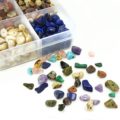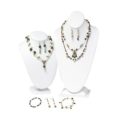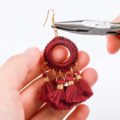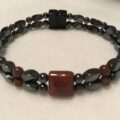Beads used in making jewelry come in an endless array of shapes, sizes and textures. The materials used for making beads are as varied as the rainbow of colors they come in. Selecting the right beads for your artwork enhances the beauty and uniqueness of each piece you create. This list explains the names of some of the most common beads as well as a little about the process used in creating them.
Acrylic beads are molded out of acrylic epoxy. Dyes are added directly into the epoxy before it is poured into the bead mold. When the resin is cured, the beads are very hard and have a nice shine to them.
Ceramic beads are fashioned from clay and go through a long drying process. The beads are made from a variety of clay with differing pigmentation. After the beads are formed, they are sometimes painted and then fired in a kiln. This process makes them extremely hard and resilient.
Charlottes are a type of seed bead that is manufactured with glass. The beads have two cut surfaces that add a luxurious essence to each bead. These beads tend to be very tiny in size and are used as groupings or to accent larger beads.
Chatons are beautiful beads that reflect the light, producing a sparkling effect. Glass or acrylic is cut in the desired shape and then a backing of metal foil or silver is placed on them to create the desired effect. Chatons are used in jewelry settings where the sparkle is truly eye catching.
Cloisonne beads are very colorful and really bring a piece of jewelry to life. These very intricate beads are made by filling pieces of metal with colored enamel. They are very unique and add a touch of class to your artwork.
 Donuts are beads that are shaped like a ring with a hole in the center. They can be used alone or a smaller bead can be worked into the jewelry design in the center of each donut bead.
Donuts are beads that are shaped like a ring with a hole in the center. They can be used alone or a smaller bead can be worked into the jewelry design in the center of each donut bead.
Flatbacks are beads that have one flat surface on the back so they lie flush against the skin. They can be crafted out of any number of materials. Flatbacks are also available without holes to be used in jewelry settings or as rhinestones on items.
Glass beads are crafted in a variety of ways. They can be cut so they sparkle or polished so they shine. Some types of glass beads are cut from solid glass sheets, sometimes they are molded and sometimes they are hand-blown. Each type of process creates beautiful beads that glow with light.
Lantern beads are cylindrical shaped beads made from various materials. These can be used for long strings of beads such as for necklaces and bracelets are they can be paired with other types of beads to accent larger beads.
 Pave beads are manufactured by setting very small crystals, stones or glass tightly together on a metal or clay bead. These beads are available in a variety of shapes, including round, oblong, square or hearts. They sparkle brilliantly and come in an array of colors.
Pave beads are manufactured by setting very small crystals, stones or glass tightly together on a metal or clay bead. These beads are available in a variety of shapes, including round, oblong, square or hearts. They sparkle brilliantly and come in an array of colors.
Seed, pony and crow beads are fairly basic beads with many purposes. These beads were used as trade with Native American tribes. They can be made out of glass or acrylic. Seed beads are very tiny and can be used for covering large surface areas or as spacers between larger beads. Pony beads are mid-sized beads that work well for many jewelry designs. Crow beads are large beads that are used for flashier, larger pieces of jewelry.
Tiles are flat beads that may have more than one hole through them. They can be crafted out of glass, ceramic, stone or wood. Many of them have a pattern on them that can enhance the piece of jewelry you are designing.
Finding the right beads for your jewelry project is as important as how the beads are arranged in the piece. By knowing the names of certain beads and the process used to create them will help you on your journey in creating masterpieces. The endless array of bead styles and types will keep you designing new jewelry artwork for years.




